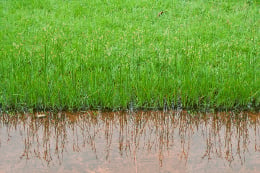Repairing Flood Damage in a Bermuda Grass Lawn
 If your bermudagrass is subject to flooding, the good news is that it is more likely to recover than any other grass seed type. However, that doesn’t mean that it will come out completely damage-free, or that you shouldn’t do everything you can to help it recover. The two most important things you can do for a flooded lawn are to assess and repair the damage.
If your bermudagrass is subject to flooding, the good news is that it is more likely to recover than any other grass seed type. However, that doesn’t mean that it will come out completely damage-free, or that you shouldn’t do everything you can to help it recover. The two most important things you can do for a flooded lawn are to assess and repair the damage.
While you might not be able to do anything for your lawn until the floodwaters recede, you can get an idea of how badly the lawn is damaged beforehand and prepare accordingly. The reason that flooding is so damaging to lawns is that it limits the amount of oxygen and sunlight that the grass can access, thereby limiting photosynthesis and the breakdown of sugars. Your lawn will be more damaged if:
• The floodwater is stagnant rather than fast moving.
• The grass is completely submerged, as opposed to the floodwater covering just the roots, crowns, or only partway up the leaves. The deeper the floodwater, the more damage will be done to the grass.
• The lawn is actively growing. Dormant lawns will incur less damage from floods.
• The water temperatures exceed 50ºF. A lawn that is submerged in 50ºF water or less can last up to 60 days, while a lawn that is submerged in water whose temperature is greater than 50ºF will be able to survive only 4 to 6 days.
Once the floodwaters have receded, your first job is to remove any debris and any silt that is thicker than ½”. Clean up the lawn, and then try to till the remaining silt into the soil. A good aeration can help increase oxygen levels in the soil, which the lawn desperately needs at this time. You should also try to apply a light fertilizer to the grass a few weeks after the flood, to help the lawn green up and begin growing again. Use only ½ of nitrogen per 1,000 sq. ft. of lawn, and pick a fertilizer whose nitrogen is in a soluble, or quick-release, form.

While you may not be able to predict or prevent floods, taking steps to repair the damage as soon as possible will keep your bermudagrass lawn healthy and growing.


